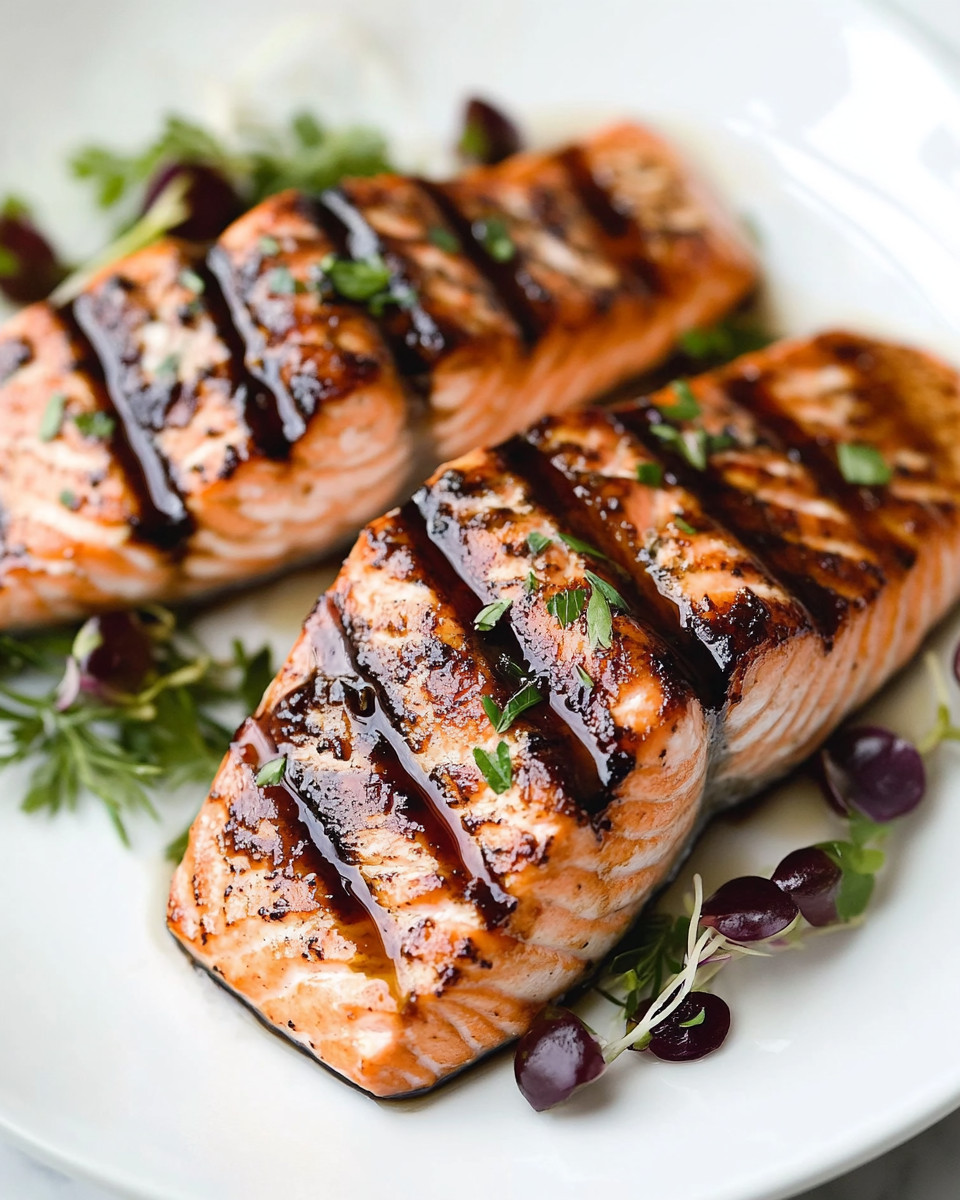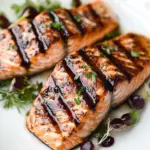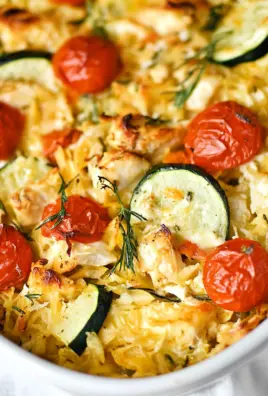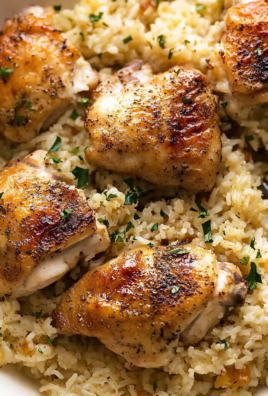Balsamic Glazed Salmon is the kind of recipe that makes you feel like a chef without needing a culinary degree. With minimal ingredients and simple steps, it delivers maximum flavor. This dish features pan-seared salmon fillets finished with a rich, tangy-sweet balsamic glaze, infused with garlic, rosemary, Dijon mustard, and honey. The glaze complements the natural richness of the salmon, creating a perfect harmony of flavors.

Whether you’re looking to elevate a weeknight dinner or serve something impressive for guests, this dish checks every box.
Why You’ll Love This Recipe
- Ready in 30 minutes with minimal prep
- Combines sweet, savory, and tangy flavors
- Uses wholesome, pantry-friendly ingredients
- Suitable for a range of diets including gluten-free and dairy-free
- The glaze works beautifully on chicken, pork, or vegetables
This dish proves that elegance doesn’t have to be complicated.
Preparation Phase & Tools to Use
Essential Kitchen Tools
To prepare this recipe efficiently, you’ll need the following tools:
- A large non-stick or stainless steel skillet
- Medium saucepan for the glaze
- Fine mesh strainer
- Heatproof bowl
- Measuring cups and spoons
- Silicone spatula or wooden spoon
- Paper towels for drying the salmon
Each tool plays a crucial role. The skillet ensures a crisp sear, the strainer removes rosemary and garlic for a silky glaze, and a reliable saucepan allows the glaze to reduce evenly without burning.
Preparation Tips
- Room Temperature Salmon: Let the fillets rest at room temperature for 10–15 minutes before cooking. This promotes even cooking.
- Dry the Fillets: Pat salmon dry to enhance browning and help the seasoning stick.
- Simmer the Glaze Gently: Watch closely as it reduces to avoid scorching the honey or mustard.
- Don’t Rush the Reduction: It should coat the back of a spoon but still pour smoothly.
Ingredients
For the Balsamic Glaze:
- ½ cup balsamic vinegar
- ¼ cup white wine or low-sodium chicken broth
- 2 tablespoons honey
- 1 tablespoon Dijon mustard
- 1 rosemary sprig (7 inches long)
- 1 clove garlic, minced
For the Salmon:
- 4 salmon fillets (6 oz each), skinless or skin-on
- Salt and freshly ground black pepper, to taste
- 2 teaspoons olive oil
- Minced rosemary or parsley for garnish (optional)
Step-by-Step Instructions
- Prepare the Salmon:
Let the salmon fillets sit at room temperature for 10–15 minutes. This ensures more even cooking. - Make the Glaze:
In a medium saucepan, combine balsamic vinegar, white wine (or broth), honey, Dijon mustard, rosemary sprig, and garlic.
Bring to a boil over medium-high heat. - Reduce the Glaze:
Lower the heat to medium-low and simmer for 10–15 minutes. Stir occasionally until the glaze reduces to about ⅓ cup.
It should be slightly thick and glossy. - Strain the Glaze:
Pour the mixture through a fine mesh strainer into a heatproof bowl. This removes solids and results in a smooth glaze. Set aside. - Season the Salmon:
Pat the fillets dry. Season both sides with salt and freshly ground black pepper. - Sear the Salmon:
Heat olive oil in a large non-stick skillet over medium-high heat.
Place the salmon skin-side up and let it sear undisturbed for 3–4 minutes. - Flip and Finish Cooking:
Flip each fillet carefully. Cook for another 2–3 minutes, or until the salmon flakes easily with a fork and is just cooked through. - Plate and Glaze:
Transfer salmon to serving plates. Drizzle generously with the balsamic glaze.
Garnish with minced rosemary or parsley if desired.
Optional Notes
- You can prepare the balsamic glaze ahead of time and store it in the refrigerator for up to five days.
Serving Suggestions
Balsamic Glazed Salmon is rich, flavorful, and beautifully balanced, making it a versatile main course. When plated with the right accompaniments, it can turn a regular meal into a restaurant-quality experience.
How to Serve Balsamic Glazed Salmon
- Drizzle extra glaze on the side for those who enjoy a stronger sweet-tangy flavor.
- Garnish with finely chopped fresh rosemary or parsley for color and an herbal finish.
- Serve the salmon over a bed of grains like quinoa, couscous, or wild rice to soak up the glaze.
- Add roasted seasonal vegetables to balance the richness of the salmon.
- Plate with intention — a clean, minimal presentation lets the dish speak for itself.
Wine Pairings
Pair this dish with a light to medium-bodied wine. Here are two ideal options:
- Pinot Noir – A red wine with low tannins that complements the glaze’s acidity.
- Chardonnay – A lightly oaked white wine that matches the salmon’s richness.
These pairings elevate the dining experience without overpowering the delicate flavor of the fish.
Common Mistakes to Avoid
Even though Balsamic Glazed Salmon is straightforward, there are a few common pitfalls that can affect flavor, texture, and presentation. Avoid these mistakes to perfect your dish every time.
Overcooking the Salmon
One of the most common errors is leaving salmon on the heat too long. This dries it out and causes it to lose its flaky, moist texture. To avoid this:
- Cook salmon to an internal temperature of 125°F (medium-rare) or up to 135°F (medium).
- Use an instant-read thermometer for best accuracy.
Skipping the Pat-Dry Step
Moisture on the surface of the salmon can interfere with proper searing. Always:
- Pat the fillets dry with paper towels before seasoning.
- Let them rest at room temperature for 10–15 minutes.
Not Straining the Glaze
Leaving solids in the balsamic glaze can lead to a gritty or uneven texture. Always:
- Use a fine mesh strainer to remove garlic and rosemary before serving.
- This ensures a smooth, glossy finish.
Rushing the Glaze Reduction
Reducing the glaze too quickly over high heat can cause it to burn or thicken unevenly. Instead:
- Reduce over medium-low heat, stirring occasionally.
- Stop once the glaze coats the back of a spoon but still pours easily.
Using Low-Quality Balsamic Vinegar
The flavor of the dish heavily depends on the quality of balsamic vinegar. Choose one that is:
- Aged for depth and complexity.
- Not overly sweet or acidic.
A quality vinegar makes the difference between a sharp, flat sauce and a well-rounded glaze.
Recommended Side Dishes
A great main dish deserves equally thoughtful side dishes. These eight options pair well with Balsamic Glazed Salmon, enhancing the meal without competing with its bold glaze.
1. Garlic Mashed Cauliflower
A lighter, low-carb alternative to mashed potatoes. Creamy texture balances the tangy glaze.
2. Lemon Herb Quinoa Salad
Bright, refreshing, and full of texture. The citrus helps cleanse the palate between bites.
3. Roasted Asparagus with Parmesan
Roasting brings out the asparagus’s sweetness, which pairs beautifully with the balsamic tones.
4. Wild Rice Pilaf
Earthy and nutty, wild rice adds contrast to the sweet glaze and complements the fish.
5. Sautéed Spinach with Garlic
A quick and nutrient-packed side. The garlic echoes flavors in the glaze for a cohesive meal.
6. Maple Glazed Carrots
If you’re doubling down on sweetness, this option mirrors the honey in the glaze while adding warmth.
7. Crispy Potato Wedges
For a heartier side, go for roasted potato wedges. Crisp exteriors and fluffy centers soak up the glaze wonderfully.
8. Grilled Zucchini and Squash
Lightly charred vegetables add smokiness and texture. A great summer pairing with grilled salmon.
Pro Tips and Flavor Variations
Perfecting Balsamic Glazed Salmon comes down to a few small adjustments that elevate the flavor and technique. Whether you’re making it for the first time or the tenth, these pro tips can help you achieve consistent, delicious results.
Cooking Tips for Best Results
- Use fresh salmon whenever possible. Wild-caught salmon offers deeper flavor and better texture.
- Watch the heat level when cooking the glaze. Simmer gently to prevent burning the honey or garlic.
- Rest the salmon for a couple of minutes after cooking. This helps redistribute the juices and keeps the fish tender.
- Glaze just before serving to maintain a clean presentation and avoid sogginess.
Flavor Variations to Try
- Add heat with a pinch of red pepper flakes or a dash of sriracha in the glaze.
- Swap the honey for maple syrup or agave nectar for a different sweetness profile.
- Use other herbs like thyme or tarragon instead of rosemary for a fresh twist.
- Add citrus zest to the glaze for a more vibrant finish.
- Try this glaze on other proteins such as chicken thighs, pork chops, or even tofu for a vegetarian alternative.
These simple modifications allow you to tailor the dish to your personal taste or seasonal ingredients.
Storage and Reheating Instructions
Storing and reheating Balsamic Glazed Salmon properly ensures it remains just as satisfying the next day.
Storage Tips
- Refrigerate leftovers in an airtight container within 2 hours of cooking.
- Store the salmon and glaze separately when possible to maintain the texture of the fish.
- Consume within 3 days for the best quality.
Reheating Instructions
- Skillet Method: Reheat salmon over low heat in a non-stick pan with a splash of water or broth. Cover with a lid to keep it moist.
- Oven Method: Wrap salmon loosely in foil and heat at 300°F for 10–12 minutes until warmed through.
- Avoid microwaving if possible, as it tends to dry out the salmon and alter its texture.
Freezing
- While fresh salmon is best, you can freeze cooked salmon for up to 1 month.
- Store in an airtight container or tightly wrapped in freezer-safe foil.
- Thaw overnight in the refrigerator before reheating.
Frequently Asked Questions
Can I bake the salmon instead of pan-searing?
Yes. To bake, place seasoned fillets on a parchment-lined baking sheet and cook at 400°F for 12–15 minutes. Drizzle the warm glaze over just before serving.
What kind of balsamic vinegar should I use?
Use a high-quality aged balsamic vinegar for the best flavor. Avoid versions with added sugar or artificial thickeners.
Is this recipe gluten-free?
Yes, as long as your broth and mustard are gluten-free. Always check labels to ensure compliance with dietary restrictions.
Can I make the glaze ahead of time?
Absolutely. The glaze can be made up to 5 days in advance. Store it in the refrigerator and gently reheat before serving.
Can I use dried rosemary?
You can substitute dried rosemary if fresh isn’t available. Use about 1 teaspoon of dried in place of the whole sprig, but strain the glaze well to remove any coarse bits.
What if my glaze becomes too thick?
Add a teaspoon of water or broth to loosen the glaze. Reheat gently and stir until smooth and pourable.
How do I know when salmon is fully cooked?
The salmon is done when it flakes easily with a fork and reaches an internal temperature of 125°F to 135°F, depending on your preferred level of doneness.
Conclusion
Balsamic Glazed Salmon is proof that you can create a restaurant-quality dish in under 30 minutes using simple, fresh ingredients. The balance of sweet, tangy, and savory flavors makes it an instant favorite for both weeknight meals and special occasions. It’s easy to prepare, quick to clean up, and endlessly versatile.
Whether you stick with the classic preparation or experiment with variations and pairings, this recipe is a guaranteed way to make salmon exciting again. Serve it with your favorite sides, store leftovers for later, and keep the glaze recipe in your back pocket for endless future meals.
For more recipes like this, check out our other seafood dishes and gourmet weeknight dinners.
Balsamic Glazed Salmon
Ingredients
For the Balsamic Rosemary Glaze:
- ½ cup balsamic vinegar
- ¼ cup white wine or low-sodium chicken broth
- 2 tablespoons honey
- 1 tablespoon Dijon mustard
- 1 rosemary sprig about 7 inches long
- 1 clove garlic minced
For the Salmon:
- 4 6 oz salmon fillets, skinless or skin-on
- Salt and freshly ground black pepper to taste
- 2 teaspoons olive oil
- Finely minced rosemary or parsley for garnish (optional)
Instructions
- Let the salmon fillets rest at room temperature for 10–15 minutes before cooking.
- In a medium saucepan, combine the balsamic vinegar, white wine (or broth), honey, Dijon mustard, rosemary sprig, and garlic. Bring to a boil over medium-high heat.
- Reduce heat to medium-low and simmer until the mixture has thickened and reduced to about ⅓ cup, around 10–15 minutes. Stir occasionally.
- Strain the glaze through a fine mesh strainer into a heatproof bowl. Set aside.
- Pat the salmon fillets dry with paper towels and season both sides with salt and pepper.
- Heat the olive oil in a large non-stick skillet over medium-high heat. Add the salmon fillets, skin-side up if applicable, and sear without moving for 3–4 minutes until the bottoms are nicely browned.
- Flip each fillet and cook for another 2–3 minutes, or until the salmon is just cooked through and flakes easily with a fork.
- Plate the salmon and drizzle generously with the balsamic glaze. Garnish with minced rosemary or parsley if desired.




Leave a Comment